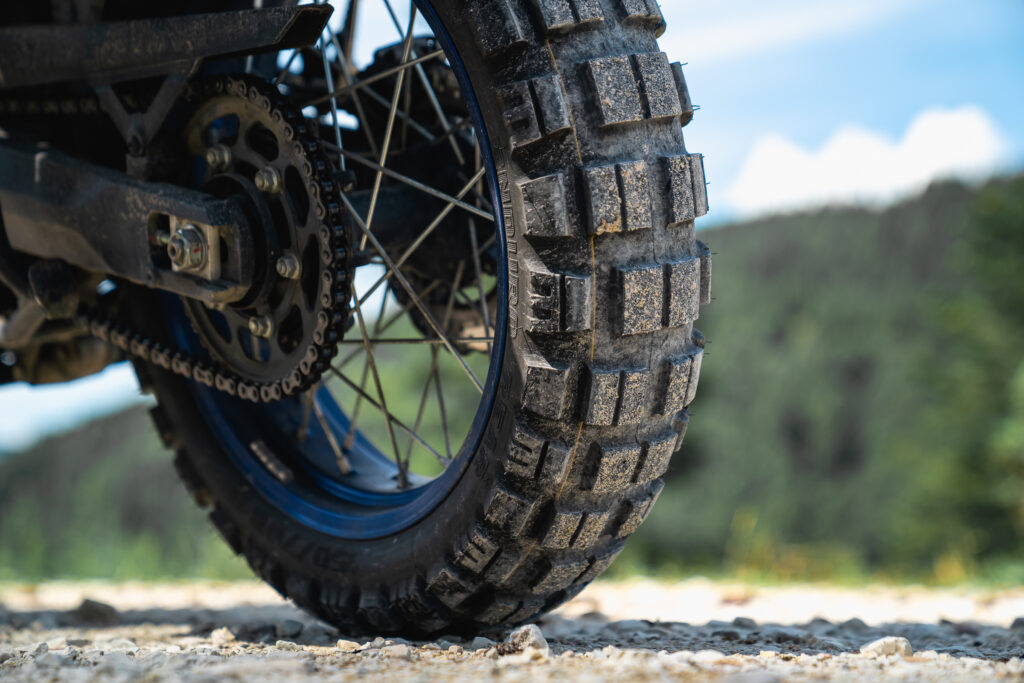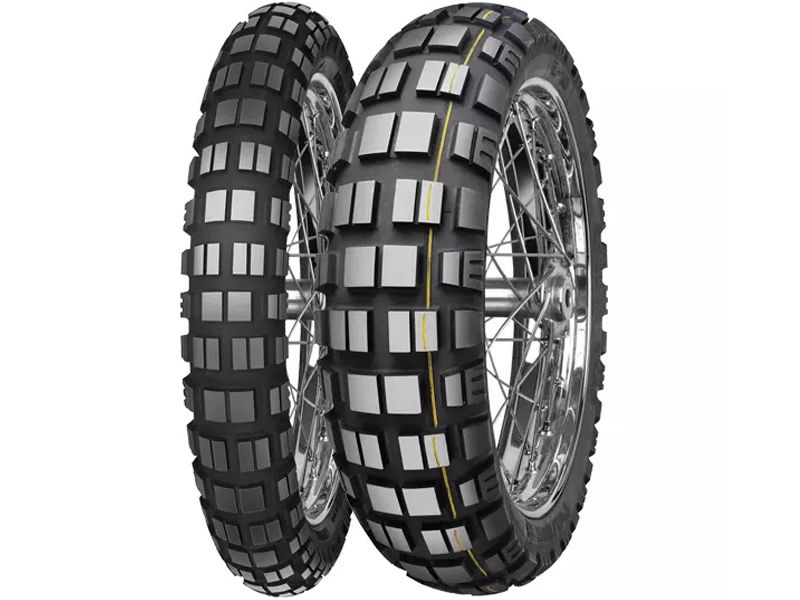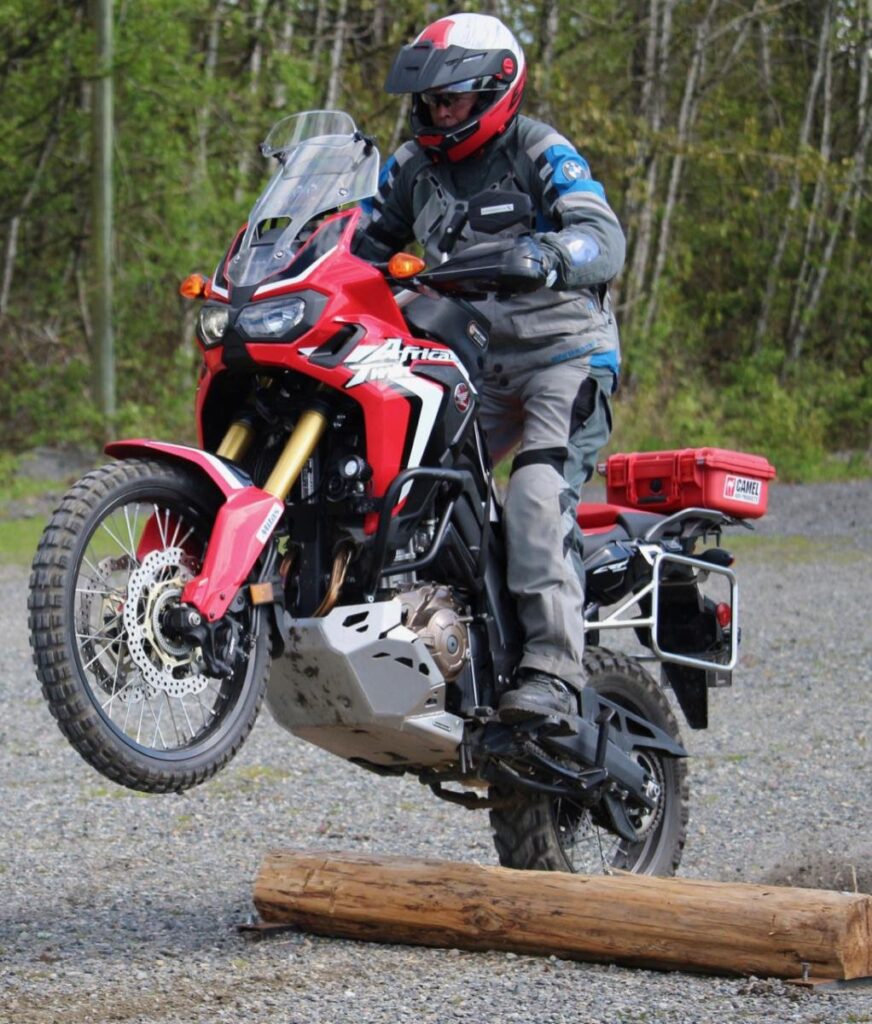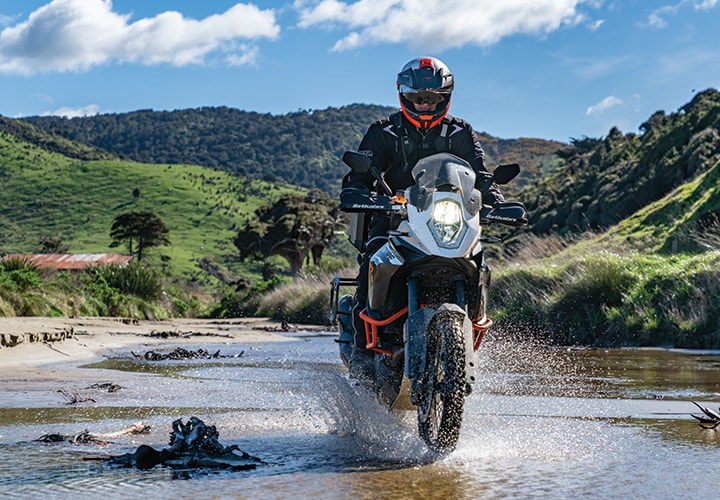Introducing the Mitas E10 Dakar Tires
Today, we set out on an exhilarating journey, taking the 1190 adventure motorcycle into uncharted terrains. Our companion for the day? The much-talked-about Mitas E10 Dakar tires. Designed for the thrill-seekers, these tires boast a 60% off-road and 40% on-road performance ratio. A first glance reveals their intriguing block spacing, standing out significantly from many other tires in the 50/50 segment. One might describe its design as a fusion between the TKC 80 and the Kenda Big Block tire.
But what truly sets this tire apart are the distinctive features embedded into its block pattern.
The Unique Pattern of the Mitas E10
Diving deeper into the Mitas E10, what instantly grabs attention is its alternating lug pattern. Strategically positioned at the center and sides of the tire, these alternating lugs enhance stability, especially during sharp turns. Another notable design element is the split in every other lug towards the tire’s side, enabling it to function as two separate lugs on the surface. Moreover, the tapered side blocks are hard to miss. They not only enhance the tire’s aesthetics but also promise an extra grip, especially on the sidewalls.
Keeping uniformity with our tests, we opted for a 30 psi pressure for both front and rear tires, ensuring an optimal balance for both on-road and off-road terrains.
Real-world Performance Insights
True to our testing ethos, we disabled ABS and traction control and maintained a cold tire pressure of 30 psi. Our initial trial took us over rocky terrains, offering a preliminary feel of the tires. As with many knobby tires, there’s often a challenge navigating specific terrains. Between speeds of 55 to 75 miles an hour, many tires exhibit a wobbling sensation. However, cruising at 70 with the Mitas E10, the front end remained impressively stable.
Our journey then took us to the washers, providing a firsthand experience of the tire’s traction on gravelly roads. The initial acceleration was commendable, though the rear did exhibit a slight drift. This drift, while not uncommon, was surprising given the tire’s square block design. Nevertheless, the power and speed achieved with just a throttle twist were remarkable. As we ventured deeper into the wash, the tire continued to impress, reaffirming its prowess in diverse terrains.
Unpacking the Sidewind Action on Mitas E10 Tires
Exploring the performance of the Mitas E10 tires, one can’t help but notice the sidewind action. While it doesn’t come close to the intensity experienced on the e07 plus, it’s still palpable. Riding downhill, the forward momentum of these tires truly stands out. The design and grip ensure that descents, even on challenging terrains, are handled with aplomb. On certain terrains, like a deceptive hill with a powdery underlayer masked by rocks on top, some tires may falter. However, the Mitas E10 not only tackled it effortlessly but also showcased impressive stopping power, halting at almost half the distance than several other competitor tires.
The Adventure on Old Waterman Canyon
Old Waterman Canyon, a relatively less-traveled backcountry road in the USA, has always been an unpredictable stretch. From tar snakes to landslides, this road has seen it all. While navigating this rugged path, the Mitas E10 exhibited impressive control. Many tires tend to lose their grip and slide away, especially on the corners. Yet, the Mitas E10, even when pushed, maintains its grip. When you gradually ease into a corner, the tire clings on, providing an assuring grip. However, a quick acceleration might lead to a slight drift, which is expected from a tire that leans 40% towards road performance.
The Remarkable Stickiness of the Mitas E10
The stickiness of the Mitas E10 is undeniably one of its standout features. It offers a controlled grip that doesn’t just ensure safety, but also boosts the rider’s confidence. As we transitioned into the off-road segment of our journey, the tires were put to test on gravel roads. These roads can be unpredictable, varying greatly with each ride. On this particular day, the path comprised a hard-packed layer underneath, covered with marble-like rocks on the surface. While many street-oriented tires struggle to find their grip on such terrains, the Mitas E10 performed remarkably well. Whether you wish to drift on these gravel roads or accelerate, the tires responded commendably, pushing the bike forward with ease and stability.
Navigating Rocky Terrains with Mitas E10 Tires
The rocky section ahead promised to be the most challenging part of the entire trip. The boulders, intimidating in size, were a testament to how some of the 80-20 and 50-50 tires struggled to maintain stability, bouncing uncontrollably. A notable mention would be the hide now k-60 scout, which was far from smooth in this terrain. However, in stark contrast, the Dakar version of the tire, renowned for its robust sidewall and tread configuration, delivered a surprisingly comfortable ride. Riding over these jagged rocks at a considerable speed, it was evident the terrain had been further roughened since our last visit. Yet, the Mitas E10 tire moved forward with unwavering determination.
A Deeper Dive into the Mitas E10 Performance
Further into the journey, unexpected hurdles like the deep pits, possibly the handiwork of a four-wheeled vehicle, cropped up. The challenge was maneuvering the motorcycle, shifting to the second gear, and maintaining balance. Testing the brakes further, it was heartening to note the firm grip of the front tire. Unlike many other tires with insufficient side knobs, the Mitas E10 resisted skidding down the slope, ensuring a trustworthy descent. One of the most scenic parts of this ride was navigating through the picturesque mountains with dirt roads intertwining. The only downside? You’d need a license plate to enjoy this terrain. The tire, once again, proved its mettle, handling the section with finesse.
Mitas E10 Tires in Wet Weather
Weather plays a crucial role in determining a tire’s performance. Almost deciding to switch these tires the previous day, the rain provided an opportunity to gauge their efficacy in wet conditions. With the traction control turned off, there was a noticeable power in the rear tire, evident both audibly and visually. Navigating flat freeways, especially the ones marked with California’s rain grooves and twisties, the Mitas E10’s performance was exemplary for a full knobby tire. However, a slight skid in the wet corners served as a reminder – while the tire is competent for moderate wet weather riding, those seeking a more aggressive ride might want to consider other options. Whether it’s crossing a creek or tackling a rainy stretch, the Mitas E10 ensures a reliable and safe journey.
Discovering Varied Terrains with Mitas E10 Tires
One of the striking realizations while riding through creek areas was the contrasting softness compared to the higher terrains. Contrary to expectations, the creek beds were much softer. Cruising effortlessly in third gear, the tires consistently provided the needed traction. The changing terrain, shifting from a sandy texture to a more clay-like base, was evident from the darker earth tones. Observing the puddles, it became clear that these were the rare muddy spots in the vicinity, primarily due to their clay composition. These mud spots, perched atop the mountain, would soon be our playground.
Challenging the Mitas E10 Tires: Mud and Wet Rocks
Examining the tire’s performance in muddy terrains revealed its stellar ability to penetrate the ground, even in varying consistencies. While some spots were softer and squishier, the tire’s efficiency remained unaffected, especially during hill climbs. An interesting test came in the form of a wet rock path, a section unexplored after heavy rains. Would the rocks, with damp ground beneath, offer a firm grip or cause the tires to skid? Despite some close calls, the adventure motorcycle’s versatility shone through, navigating smoothly through mud, rivers, and standing water, and transitioning seamlessly onto the pavement.
An In-Depth Examination: Mitas E10 Tires After A Rigorous Ride
Post-journey, inspecting the front tire revealed significant wear on its corners. This indicated the tire’s robust grip on the road, especially during turns. However, the tire’s center lugs remained untouched, even with hard off-road braking. The rear tire, on the other hand, showed noticeable wear, particularly on the leading edges. The soft tread compound of the Mitas E10, while ensuring excellent asphalt grip, also led to faster wear. Its distinct flat profile, as opposed to the more rounded designs in similar segments, was evident. Notably, despite an adventurous ride, the tire’s side lugs demonstrated substantial wear, indicating the degree of leans during the journey.
Conclusion: Reflecting on the Mitas E10 Dakar Tire’s Performance
The Mitas E10 Dakar tire’s adventure through varied terrains paints a comprehensive picture of its capabilities and limitations. Its exceptional performance across creek beds, muddy spots, and wet rocks underscores its versatility. The tire’s ability to switch from challenging off-road terrains to smooth pavements without compromising on performance is commendable. However, the discernable wear, particularly on the rear tire, suggests a softer tread compound, which, while ensuring grip, may affect its longevity.
For riders seeking a mix of adventure and performance, the Mitas E10 emerges as a reliable choice. Its adaptability across terrains coupled with its robust grip makes it an asset for adventure motorcycling. While its wear patterns indicate areas for potential improvement, its overall performance affirms its position as a top contender in its segment.








